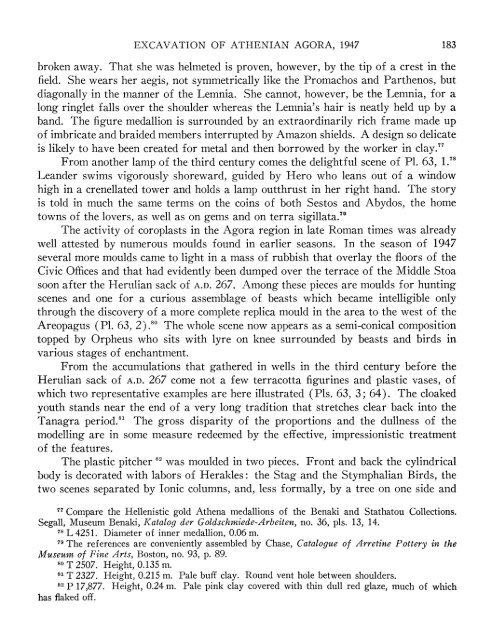the excavation of the athenian agora twelfth season: 1947
the excavation of the athenian agora twelfth season: 1947
the excavation of the athenian agora twelfth season: 1947
You also want an ePaper? Increase the reach of your titles
YUMPU automatically turns print PDFs into web optimized ePapers that Google loves.
EXCAVATION OF ATHENIAN AGORA, <strong>1947</strong> 183<br />
broken away. That she was helmeted is proven, however, by <strong>the</strong> tip <strong>of</strong> a crest in <strong>the</strong><br />
field. She wears her aegis, not symmetrically like <strong>the</strong> Promachos and Par<strong>the</strong>nos, but<br />
diagonally in <strong>the</strong> manner <strong>of</strong> <strong>the</strong> Lemnia. She cannot, however, be <strong>the</strong> Lemnia, for a<br />
long ringlet falls over <strong>the</strong> shoulder whereas <strong>the</strong> Lemnia's hair is neatly held up by a<br />
band. The figure medallion is surrounded by an extraordinarily rich frame made up<br />
<strong>of</strong> imbricate and braided members interrupted by Amazon shields. A design so delicate<br />
is likely to have been created for metal and <strong>the</strong>n borrowed by <strong>the</strong> worker in clay.77<br />
From ano<strong>the</strong>r lamp <strong>of</strong> <strong>the</strong> third century comes <strong>the</strong> delightful scene <strong>of</strong> P1. 63, 1L78<br />
l1eander swims vigorously shoreward, guided by Hero who leans out <strong>of</strong> a window<br />
high in a crenellated tower and holds a lamp outthrust in her right hand. The story<br />
is told in much <strong>the</strong> same terms on <strong>the</strong> coins <strong>of</strong> both Sestos and Abydos, <strong>the</strong> home<br />
towns <strong>of</strong> <strong>the</strong> lovers, as well as on gems and on terra sigillata."9<br />
The activity <strong>of</strong> coroplasts in <strong>the</strong> Agora region in late Roman times was already<br />
well attested by numerous moulds found in earlier <strong>season</strong>s. In <strong>the</strong> <strong>season</strong> <strong>of</strong> <strong>1947</strong><br />
several more moulds came to light in a mass <strong>of</strong> rubbish that overlay <strong>the</strong> floors <strong>of</strong> <strong>the</strong><br />
Civic Offices and that had evidently been dumped over <strong>the</strong> terrace <strong>of</strong> <strong>the</strong> Middle Stoa<br />
soon after <strong>the</strong> Hertlian sack <strong>of</strong> A.D. 267. Among <strong>the</strong>se pieces are moulds for hunting<br />
scenes and one for a curious assemblage <strong>of</strong> beasts which became intelligible only<br />
through <strong>the</strong> discovery <strong>of</strong> a more complete replica mould in <strong>the</strong> area to <strong>the</strong> west <strong>of</strong> <strong>the</strong><br />
Areopagus (P1. 63, 2).8? The whole scene now appears as a semi-conical composition<br />
topped by Orpheus who sits with lyre on knee surrounded by beasts and birds in<br />
various stages <strong>of</strong> enchantment.<br />
From <strong>the</strong> accumulations that ga<strong>the</strong>red in wells in <strong>the</strong> third century before <strong>the</strong><br />
Herulian sack <strong>of</strong> A.D. 267 come not a few terracotta figurines and plastic vases, <strong>of</strong><br />
which two representative examples are here illustrated (Pls. 63, 3; 64). The cloaked<br />
youth stands near <strong>the</strong> end <strong>of</strong> a very long tradition that stretches clear back into <strong>the</strong><br />
Tanagra period.8' The gross disparity <strong>of</strong> <strong>the</strong> proportions and <strong>the</strong> dullness <strong>of</strong> <strong>the</strong><br />
modelling are in some measure redeemed by <strong>the</strong> effective, impressionistic treatment<br />
<strong>of</strong> <strong>the</strong> features.<br />
The plastic pitcher 8 was moulded in two pieces. Front and back <strong>the</strong> cylindrical<br />
body is decorated with labors <strong>of</strong> Herakles: <strong>the</strong> Stag and <strong>the</strong> Stymphalian Birds, <strong>the</strong><br />
two scenes separated by Ionic columns, and, less formally, by a tree on one side and<br />
77 Compare <strong>the</strong> Hellenistic gold A<strong>the</strong>na medallions <strong>of</strong> <strong>the</strong> Benaki and Stathatou Collections.<br />
Segall, Museum Benaki, Katalog der Goldschmniede-Arbeiten, no. 36, pls. 13, 14.<br />
78 L 4251. Diameter <strong>of</strong> inner medallion, 0.06 m.<br />
79 The references are conveniently assembled by Chase, Catalogue <strong>of</strong> Arretine Pottery in <strong>the</strong><br />
Museum <strong>of</strong> Fine Arts, Boston, no. 93, p. 89.<br />
80 T 2507. Height, 0.135 m.<br />
81 T 2327. Height, 0.215 m. Pale buff clay. Round vent hole between shoulders.<br />
82 p 17,877. Height, 0.24 m. Pale pink clay covered with thin dull red glaze, much <strong>of</strong> which<br />
has flaked <strong>of</strong>f.

















